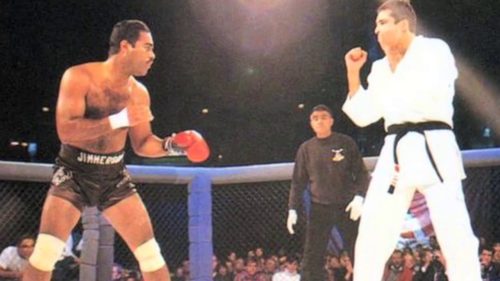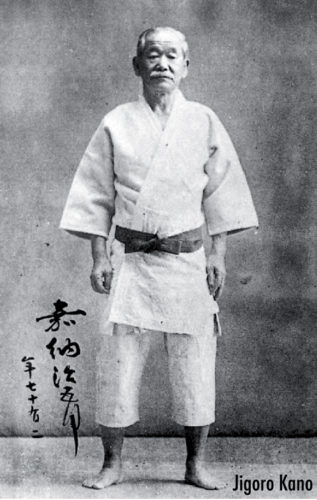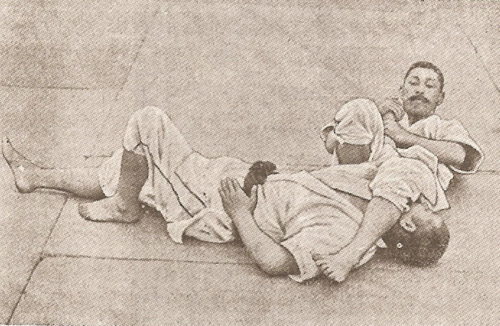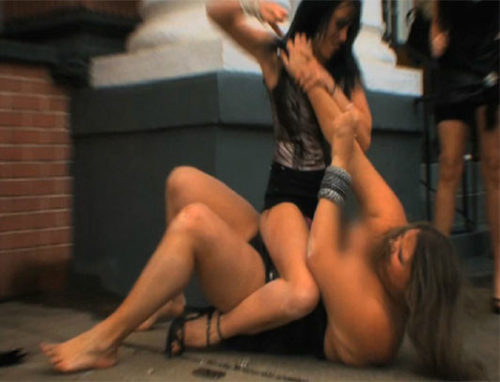[amazon_link asins=’B00H3S40S0,1977796745,1608851400,B015UQ5IN2,B001EIE97W’ template=’ProductCarousel’ store=’spoup-20′ marketplace=’US’ link_id=’b32d89db-005b-11e8-90ea-89d236139fc9′]
Many people would argue that the most important event in martial arts history was when a largely unknown slender Brazilian by the name of Royce Gracie entered a no-holds-barred competition and defeated all comers of all sizes using a martial art called “Gracie Jiu-Jitsu.”
While I wouldn’t exactly disagree with that it’s important to understand a few historical elements of the martial arts. Insight into the past does a great for us as far as providing foresight for the future. With that being said this was not the first time “ground fighters” or fighters who use live ground grappling as their primary Training Method facilitated a monumental shift in how other martial arts train. Another well-known martial art that took over as one of Japan’s top fighting systems was Kodokan Judo founded by Jigoro Kano. However prior to the 1900s there was little or no ne-waza (ground grappling techniques) as part of the Judo system until an unknown School of Jujitsu calling themselves the Fusen Ryu challenged the Kodokan.
Up until the early nineteen-hundreds the Kodokan was widely known across Japan as an undefeated sect within classical Jujitsu. Their first loss however came at the hands of the fighters from the Fusen Ryu lineage led by Mataemon Tanabe. Little is known about the Fusen Ryu School other than they did something that was quite uncommon for the time; which was focus extended periods of training time on live ground grappling.
Many of the exact details are unclear or remain in obscurity on what exactly happened and what the exact time frame was or what events led to the challenge between the Fusen Ryu and the Kodokan. However, what is clear is that while the Kodokan were overwhelming victorious among the other classical Jujitsu factions it was the the Fusen Ryu fighters who were the first to give the Kodokan a decisive loss.
The agreement between the two schools was that the only acceptable form of victory would be from submission. Most accounts of the matches are unanimous in that the representatives of Fusen Ryu used the tactic of sitting down as soon as the match begin thus forcing the challenge match into the realm of ground grappling.
As the old saying goes; The lion may be king of the jungle. “…But you throw him into the Shark Tank and he’s just another meal.” – Renzo Gracie
The Kodokan were unable to fend off the attacks of the Fusen Ryu Fighters and were all defeated by submission.
What the Kodokan then realized was the value of live ground grappling and incorporated the training methods into Judo which in turn established within the culture of Judo that a competent Judoka must be proficient in not only tachi-waza (standing techniques) but ne-waza (ground techniques) as well.
Of note: All combat sport events have the same elements involved in the there is an agreement between the participants to abide by certain restrictions such as no one else is going to get involved, no one is going to be armed, etc.
This is also an appropriate time to mention that while all martial arts arise from the people having a need to fight sport serves a great deal to improve the technical ability of the practitioners involved as well as improving the martial art as a whole. It’s also important to understand that while challenge matches have a more liberal rule-set generally speaking it’s important to recognize while being the closest thing to a “real fight” as possible they are still very much competitive sporting events as all the other combat sporting events we watch because they have that general agreement. It is important to realize that sport also serves to take the martial art off azimuth from real fighting. But that is a subject for another blog on its own…
I mention/discuss the history of grappling based jujitsu (briefly from my point of view) not for the sake of discrediting the Gracie family (a family that every just a practitioner is indebted to) but to make the point that there is well over a centuries worth of historical and empirical data that tells us what exactly what works in fights, how we should train for fights, and that our enemies are constantly analyzing us to determine our weaknesses’ and they will exploit them as soon as the given opportunity presents itself.
The same way the Fusen Ryu School exploited the inability of the Kodokan in ground grappling the Kodokan exploited the weakness’ of the other classical Jujitsu factions with their limited knowledge of clinch fighting. Now that is not to confuse this fact with the other classical jujitsu schools lacking knowledge of grappling what so ever. What separated the Kodokan and the Fusen Ryu from them was the Training Method of randori or live training.
Live Training is not only a fantastic training method it does a great deal for us as martial artists. The first of which is that it serves as a filter both personal and professional (as a teacher or coach) to what techniques actually work against fully resistant opponents. The techniques that work will continue to be passed on while the ones that don’t will be filtered through and discarded. The second of which is that it serves as a professional and personal technique generator.
My experience in both teaching and in practice has been that progression in the martial arts happen in peaks. As you’re continuing to train with the same people and improving your personal skill set they are improving as well. The rate differentiates depending on how many times a week and individual trains but none-the-less everyone is improving together. So as you begin to solve problems your training partners present, your training partners will then come up with new problems for you to solve and vice versa. This is the reason for the long periods of stagnation that many practitioners experience and can sometimes grow frustrated with (aside from some of the personal emotional challenges that come from being forced into submission constantly).
Now we fast forward to present day; the new world of martial arts with MMA taking over the world as the fastest growing sport. Also interesting is that while many of the criticisms of MMA fighters having a severe disadvantage against specialized Fighters there has been a number of events to disprove this claim. The most notable of which being the Mayweather vs. McGregor boxing match, the recent professional boxing debut of Michael “Venom” Page, but before that there have been many grappling events to display the same, such as Rousimar Palhares an MMA fighter coming in second place in the ADCC tournament losing only to Andre Galvão. Arguably one of the best sport Jiu Jitsu players to ever live.
Grappling has come a long way in the combat sports but what is generally unknown to the public is what changes in warfare grappling has played. Of the close to 1,000 post action interviews collected largely by Matt Larsen of the MACP what the military concluded was that every single fight was a grappling match. Now that is not to say that we are exactly talking the ground grappling of Brazilian Jiu Jitsu but some type of clinching, grabbing, and/or grounded exchange where either the Soldier is grabbed or the Soldier has to go hands on. Now that is a pretty significant piece of information because despite all the warriors of times past that we honor and idolize; the modern warriors of the Global War on Terror on are the most professional and destructive fighting force known to mankind. They KNOW how to win fights and if grappling is a valuable skill to have to them; what is there left to say? This is something I struggle to explain largely with the many of the traditional martial artists’.
The traditional martial arts (TMA’s) are continuing to dwindle and fade into irrelevance not because the techniques aren’t functional but their training methods are antiquated to say the least. Many of them hide behind the fact that there are time limits and rules imposed on Mixed Martial Arts as well as other Proving Ground events but the fact is that if your Martial Art cannot hold its own within a controlled environment it will definitely fail in an uncontrolled environment. There are also many logical fallacies of being able to employ Force escalation techniques such as eye gouging, groin strikes, pressure points, etc. From we would call positions lower on the positional hierarchy.
What these critics fail to realize first is that all (real) fights have time limits. The time limits are imposed by whatever the tactical situation is. At the macro level help is on the way for the enemy maybe the use of some good old fashioned track and field might be my best option to survive that encounter or maybe QRF is on the way so I need to ensure the enemy is unable to break contact. At the micro; bar fight breaks out we all know the cops are coming. Secondly is the concept of hierarchy of positions (a concept as far as I know that is credited to the Gracie family) is not just where you want to be in a ground grappling match but it also serves as a battle plan to gain positional advantages over your adversary and enemy. While it is true the enemy may be able to escalate the use of force from non dominant positioning but what has to be understood is that so can I. Not only can I do what he does to me but I can do it better and I can do it much more effectively than he can because I am in a position of dominance and more importantly a position of leverage.
Now to the adherent this will read as an anti-TMA or a pro-BJJ so I’d like to take this opportunity to point out that as a student of violence I couldn’t be any less concerned about what martial art to practice. I’m very much interested in winning fights along with teaching others how to win fights. I respect people and desire results; ideas and theory do nothing to make sure people are going to come home alive. Using the past to guide our future we must also be aware that the enemy is constantly adapting. As we continue to produce solutions to problems presented by our adversary, our adversaries will present new problems until one of us finds an opening to finish the other. In the age of information what happens in real fight and what works in real fights is no longer a subject that is up for any type of academic debate.
Let me take a moment to speak plainly; if MMA fighters aren’t doing it(insert X martial art here), it’s not worth doing. If your instructor has avoided competition or learning the elements of MMA (BJJ, Judo, Wrestling, Sambo, Muay Thai, Boxing, Kickboxing) you should avoid them. There is no proving ground that is as close to real fighting as MMA. Believe it, accept it, it’s true. Now that is not to say that there aren’t trace elements in TMA’s that we can learn from as modern martial artist.
To this day there are many people/charlatans are continuing to furnish to students “counter to X” plans. There is no such move or technique set to counter another skill set. The only way to defend against any fight plan is to be good at executing that fight plan. If what you’re doing can be stopped with the simple plan of CLOSE-DOMINATE-FINISH it’s time for you to realize the ice age has come and you are not one of the pioneers of the new world. You are one of the dinosaurs…
*The views and opinions expressed on this website are solely those of the original authors and contributors. These views and opinions do not necessarily represent those of Spotter Up Magazine, the administrative staff, and/or any/all contributors to this site.
[amazon_link asins=’B00H3S40S0,1977796745,1608851400,B015UQ5IN2,B001EIE97W’ template=’ProductCarousel’ store=’spoup-20′ marketplace=’US’ link_id=’b32d89db-005b-11e8-90ea-89d236139fc9′]
Brought to you by the dudes at C4 Combatives





